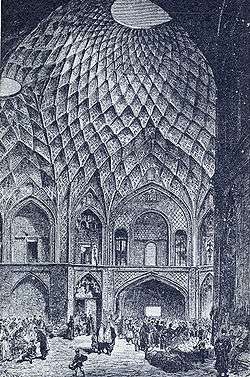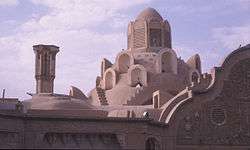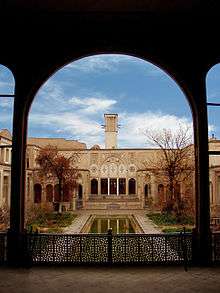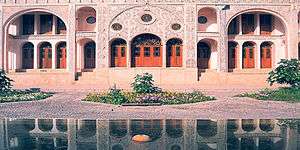Kashan
| Kashan کاشان | |
|---|---|
| city | |
|
Tabatabaei House, early 1800s, Kashan. A fine example of traditional Persian architecture. | |
 Kashan Location in Iran | |
| Coordinates: 33°59′N 51°26′E / 33.983°N 51.433°ECoordinates: 33°59′N 51°26′E / 33.983°N 51.433°E | |
| Country |
|
| Province | Isfahan |
| County | Kashan |
| Bakhsh | Central |
| Population | |
| • city | 322,557 |
| • Urban | 352,527 |
| • Metro | 372,557 |
| Time zone | IRST (UTC+3:30) |
| • Summer (DST) | IRDT (UTC+4:30) |
| Website | Kashan.ir |






Kashan (Persian: کاشان, also Romanized as Kāshān; also known as Kachan)[1] is a city in and the capital of Kashan County, in the province of Isfahan, Iran. At the 2006 census, its population was 248,789, in 67,464 families.[2]
The etymology of the city name comes from the Kasian, the original inhabitants of the city, whose remains are found at Tapeh Sialk dating back 9,000 years; later this was changed to "Kashian", hence the town name. Between the 12th and the 14th centuries Kashan was an important centre for the production of high quality pottery and tiles. In modern Persian, the word for a tile (kashi) comes from the name of the town.
Kashan is cited in the neighbourhood of two of highest peaks of Karkas chain, Mount Gargash to the southwest of Kashan (the home of Iran national observatory, the largest astronomical telescope of Iran) and Mount Ardehaal in the west of Kashan, also known as "Damavand of Kashan" and the highest peak of Ardehaal mountains (end part of Karkas chain in central Iran).
History
Archeological discoveries in the Sialk Hillocks which lie 4 km west of Kashan reveal that this region was one of the primary centers of civilization in pre-historic ages. Hence Kashan dates back to the Elamite period of Iran. The Sialk ziggurat still stands today in the suburbs of Kashan after 7,000 years.
The artifacts uncovered at Sialk reside in the Louvre in Paris and the New York Metropolitan Museum of Art, and Iran's National Museum.
By some accounts although not all Kashan was the origin of the three wise men who followed the star that guided them to Bethlehem to witness the nativity of Jesus, as recounted in the Bible.[3] Whatever the historical validity of this story, the attribution of Kashan as their original home testifies to the city's prestige at the time the story was set down.
Abu-Lu'lu'ah/Pirouz Nahāvandi, the Persian soldier who was enslaved by the Islamic conquerors and eventually assassinated the caliph Umar al-Khattab in AH 23 (643/4 CE), reportedly fled to Kashan after the assassination and lived there some years before being finally caught and executed. His tomb is one of Kashan's conspicuous landmarks (see gallery below).
Sultan Malik Shah I of the Seljuk dynasty ordered the building of a fortress in the middle of Kashan in the 11th century. The fortress walls, called Ghal'eh Jalali still stand today in central Kashan.
Kashan was also a leisure vacation spot for Safavi Kings. Bagh-e Fin (Fin Garden), specifically, is one of the most famous gardens of Iran. This beautiful garden with its pool and orchards was designed for Shah Abbas I as a classical Persian vision of paradise. The original Safavid buildings have been substantially replaced and rebuilt by the Qajar dynasty although the layout of trees and marble basins is close to the original. The garden itself however, was first founded 7000 years ago alongside the Cheshmeh-ye-Soleiman. The garden is also notorious as the site of the murder of Mirza Taghi Khan known as Amir Kabir, chancellor of Nasser-al-Din Shah, Iran's king in 1852.

The earthquake of 1778 leveled the city of Kashan and all the edifices of Shah Abbas Safavi, leaving 8000 casualties. But the city started afresh and has today become a focal tourist attraction via the numerous large houses from the 18th and 19th centuries, illustrating the finest examples of Qajari aesthetics.
Today
Although there are many sites in Kashan of potential interest to tourists, the city remains largely undeveloped in this sector, with fewer than a thousand foreign tourists per year. Qamsar and Abyaneh are notable towns around Kashan, which attract tourists all year around. The nearby town of Niasar features a man-made cave and fireplace of historical interest.
Kashan is internationally famous for manufacturing carpets, silk and other textiles. Kashan today houses most of Iran's mechanized carpet-weaving factories, and has an active marble and copper mining industry. Kashan and suburbs have a population of 400,000.
Main sights
Kashan's architectural sights include:
- Agha Bozorg Mosque
- Āmeri House
- Boroujerdi House
- Jalali castle
- Tabātabāei House
- Abbāsi House
- Attarha House
- Al-e Yaseen House
- Sultan Amir shrine and bath
- 40 Dokhtaran Fortress
- Pirouz Nahavandi/Abu-Lu'lu'ah Shrine (the assassin of islam 's second Caliph)
- Fin Garden
- Fin Bathroom
- Ghal'eh jalali
- Jameh Mosque of Kashan
- Kashan Bazaar
- Meydan Mosque
- Sialk
- Tabriziha Mosque
- Timcheh Amin-o-dowleh
Education
Colleges and universities in Kashan include:
Roads
Kashan is connected via freeways to Isfahan and Natanz to the South, and Qom, which is an hour drive away to the north.
Famous Kashanis
- Sohrab Sepehri
- Ghyath ad-Din Jamshid Kashani
- Kamal-ol-Molk
- Mohammad-Nabi Sarbolouki
- Ustad Ali Maryam
- Muhsen Feyz Kashani
- Yedidia Shofet the former chief rabbi of Iran and the worldwide spiritual leader of Persian Jewry.
- Uriel Davidi the former chief rabbi of Iran and the worldwide spiritual leader of Persian Jewry.
- Isaac Larian is the Chief Executive Officer of MGA Entertainment
- David Alliance, Baron Alliance Businessman and a Liberal Democrat politician in the United Kingdom.
- Seyyed Hossein Nasr, Leading Islamic Philosopher and exponent of the Perennial Philosophy
- محسن نادری در آلمان
Sister cities
See also
- Iranian Architecture
- Kashan rug
- List of the historical structures in the Isfahan province
- Sialk - Kashan's ancient architecture.
- Traditional Persian residential architecture
References
- ↑ Kashan can be found at GEOnet Names Server, at this link, by opening the Advanced Search box, entering "-3069961" in the "Unique Feature Id" form, and clicking on "Search Database".
- ↑ "Census of the Islamic Republic of Iran, 1385 (2006)". Islamic Republic of Iran. Archived from the original (Excel) on 2011-11-11.
- ↑ Elgood, Cyril. A Medical History of Persia and the Eastern Caliphate: From the Earliest Times Until the Year A.D. 1932. Cambridge Library Collection - History of Medicine. Cambridge University Press, 2010. ISBN 1108015883 p. 34
External links
| Wikivoyage has a travel guide for Kashan. |
| Wikimedia Commons has media related to Kashan. |
| ||||||||||||||||||||||||||||||||||
| ||||||||||||||||||||||||||||||||||||||||||||||||||||||||||||||||||||||||||||||||||||||||||||||||||||||||||||||||||||
| ||||||||||||||||||||||||||||||||||||||||||||||||||||||||||||||||||||||||||||

